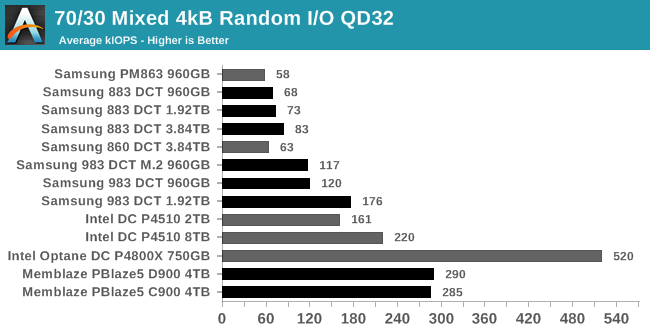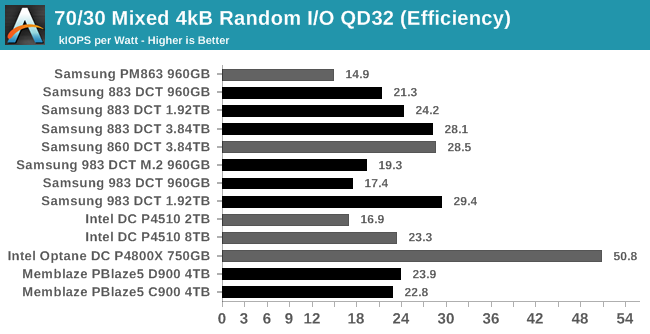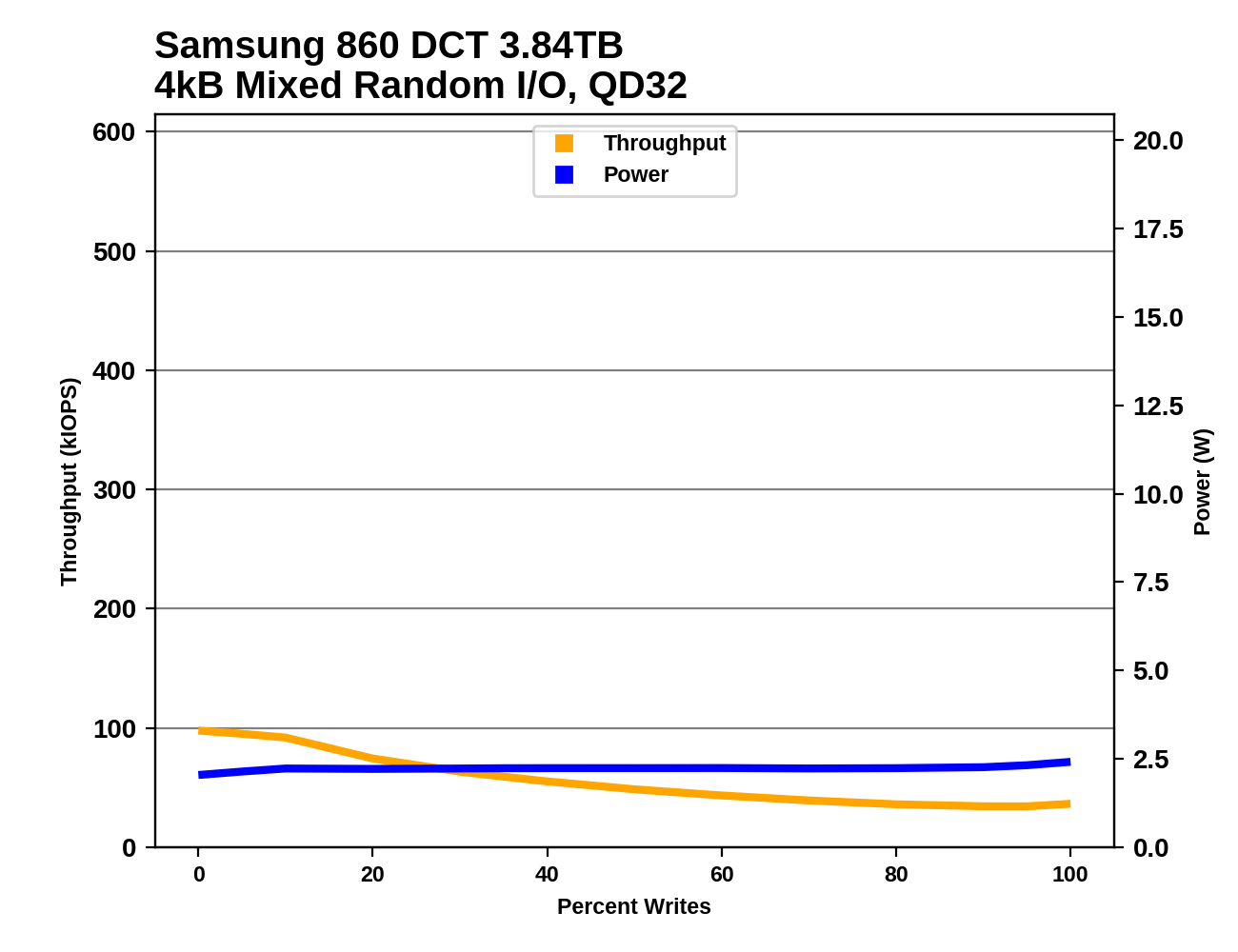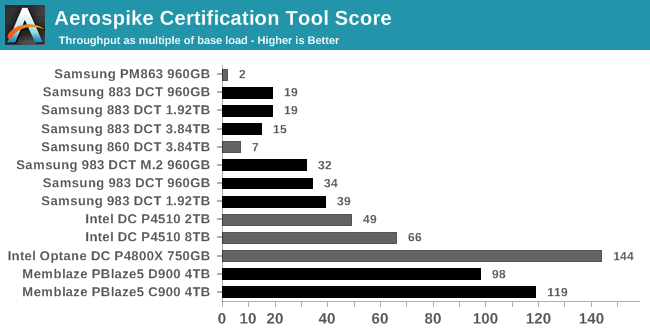The Enterpise TLC Storage Era Begins: Rounding Up 13 SSDs With Samsung, Intel, and Memblaze
by Billy Tallis on January 3, 2019 9:45 AM ESTMixed Random Performance
Real-world storage workloads usually aren't pure reads or writes but a mix of both. It is completely impractical to test and graph the full range of possible mixed I/O workloads—varying the proportion of reads vs writes, sequential vs random and differing block sizes leads to far too many configurations. Instead, we're going to focus on just a few scenarios that are most commonly referred to by vendors, when they provide a mixed I/O performance specification at all. We tested a range of 4kB random read/write mixes at queue depth 32, and also tested the NVMe drives at QD128. This gives us a good picture of the maximum throughput these drives can sustain for mixed random I/O, but in many cases the queue depth will be far higher than necessary, so we can't draw meaningful conclusions about latency from this test. As with our tests of pure random reads or writes, we are using 32 (or 128) threads each issuing one read or write request at a time. This spreads the work over many CPU cores, and for NVMe drives it also spreads the I/O across the drive's several queues.
The full range of read/write mixes is graphed below, but we'll primarily focus on the 70% read, 30% write case that is a fairly common stand-in for moderately read-heavy mixed workloads.
 |
|||||||||
| Queue Depth 32 | Queue Depth 128 | ||||||||
The SATA SSDs are all significantly slower at 70% reads than they were at 100% reads on the previous page, but the higher capacity drives come closer to saturating the SATA link. Among the NVMe drives, the Samsung 983 DCT shows no further improvement from increasing the queue depth from 32 all the way to 128, but the more powerful NVMe drives do need the higher queue depth to deliver full speed. The Intel P4510's improvement at QD128 over QD32 is relatively modest, but the Memblaze PBlaze5 almost doubles its throughput and manages to catch up to the Intel Optane P4800X.
 |
|||||||||
| QD32 Power Efficiency in MB/s/W | QD32 Average Power in W | ||||||||
| QD128 Power Efficiency in MB/s/W | QD128 Average Power in W | ||||||||
The Intel Optane P4800X is the only drive that stands out with a clear power efficiency advantage; aside from that, the different product segments are on a relatively equal footing. The different capacities within each product line all have similar power draw, so the largest (fastest) models end up with the best efficiency scores. The smaller NVMe drives like the 960GB Samsung 983 DCT and the 2TB Intel P4510 waste some of the performance potential of their SSD controllers, so from a power efficiency standpoint only the larger NVMe drives are competitive with the SATA drives.
 |
|||||||||
| QD32 | |||||||||
| QD128 | |||||||||
The SATA drives and slower NVMe drives generally show a steep decline in performance as the test progresses from pure reads through the more read-heavy mixes, accompanied by a increase in power consumption. For the more balanced mixes and the more write-heavy half of the test, those drives show slower performance decline and power consumption plateaus. For the faster NVMe drives (the Memblaze PBlaze5 and Intel Optane P4800X), power consumption climbs through most or all of the test, and they are the only drives for which increasing the queue depth beyond 32 helps on the more balanced or write-heavy mixes. Higher queue depths only help the Samsung 983 DCT and Intel P4510 for the most ready-heavy workloads.
Aerospike Certification Tool
Aerospike is a high-performance NoSQL database designed for use with solid state storage. The developers of Aerospike provide the Aerospike Certification Tool (ACT), a benchmark that emulates the typical storage workload generated by the Aerospike database. This workload consists of a mix of large-block 128kB reads and writes, and small 1.5kB reads. When the ACT was initially released back in the early days of SATA SSDs, the baseline workload was defined to consist of 2000 reads per second and 1000 writes per second. A drive is considered to pass the test if it meets the following latency criteria:
- fewer than 5% of transactions exceed 1ms
- fewer than 1% of transactions exceed 8ms
- fewer than 0.1% of transactions exceed 64ms
Drives can be scored based on the highest throughput they can sustain while satisfying the latency QoS requirements. Scores are normalized relative to the baseline 1x workload, so a score of 50 indicates 100,000 reads per second and 50,000 writes per second. Since this test uses fixed IO rates, the queue depths experienced by each drive will depend on their latency, and can fluctuate during the test run if the drive slows down temporarily for a garbage collection cycle. The test will give up early if it detects the queue depths growing excessively, or if the large block IO threads can't keep up with the random reads.
We used the default settings for queue and thread counts and did not manually constrain the benchmark to a single NUMA node, so this test produced a total of 64 threads scheduled across all 72 virtual (36 physical) cores.
The usual runtime for ACT is 24 hours, which makes determining a drive's throughput limit a long process. For fast NVMe SSDs, this is far longer than necessary for drives to reach steady-state. In order to find the maximum rate at which a drive can pass the test, we start at an unsustainably high rate (at least 150x) and incrementally reduce the rate until the test can run for a full hour, and the decrease the rate further if necessary to get the drive under the latency limits.

Samsung's SATA drives have vastly improved performance over the older PM863—even the entry-level 860 DCT is several times faster, and it's absolutely not intended for workloads that are this write-heavy. The 3.84TB 883 DCT is a bit slower than the lower capacities, but still offers more than twice the performance of the 860 DCT.
The NVMe drives all outperform the SATA drives, with the Samsung 983 DCT M.2 predictably being the slowest of the bunch. The Intel P4510 outperforms the 983 DCTs, and the Memblaze PBlaze5s are much faster still, though even the PBlaze5 C900 can't quite catch up to the Intel Optane DC P4800X.
 |
|||||||||
| Power Efficiency | Average Power in W | ||||||||
The power consumption differences between these drives span almost an order of magnitude. The latest Samsung SATA drives range from 1.6 W up to 2.7 W, while the NVMe drives start at 5.3 W for the 983 DCT M.2 and go up to 12.9 W for the PBlaze 5. However, the power efficiency scores don't vary as much. The two fastest NVMe SSDs also take the two highest efficiency scores, but then the Samsung 883 DCT SATA drives offer better efficiency than most of the rest of the NVMe drives. The SATA drives are at a serious disadvantage in terms of IOPS/TB, but for large datasets the SATA drives might offer adequate performance in aggregate at a lower TCO.










36 Comments
View All Comments
Greg100 - Saturday, January 5, 2019 - link
I have to disagree with the last sentence of this quote about Intel SSD DC P4510:“The NAND and DRAM on the inner faces of the two PCBs do not get any airflow or thermal pads bridging them to the case. This lack of cooling is one of the major motivators of Intel's Ruler form factor, now standardized as EDSFF.”
Intel's main motivation was not cooling, but charging an extra fee for the new format:
€ 5051,90 Intel SSD DC P4500 8TB, HHHL
€ 6060,90 Intel SSD DC P4500 8TB, Ruler
(Prices: IC-S Austria)
Proper cooling for inner faces of the two PCBs would be by using AMEC Thermasol Ultra flat Heat pipe (also known as flat aluminium cool pipe) connecting with case.
but hey… it’s Intel, who make incredible space technology, but can not solder i7-8700K CPU!
What the eyes don't see, the heart doesn't grieve over ;-)
Thank you very much Billy for disassemble this SSD.
So… I will have to use Fujipoly Ultra Extreme XR-m thermal pads with huge Fisher Elektronik passive heatsinks outside. Better would be AMEC Thermasol + Fujipoly Ultra Extreme XR-m inside, but I do not want to void of 5 year warranty.
Kristian Vättö - Sunday, January 6, 2019 - link
You won't find real enterprise SSD pricing online because it's strictly B2B business with volume and numerous other factors playing a big role. One SKU may be more expensive just for the fact that the demand is low, so the distributor/reseller is not getting a volume discount. The reseller may also be marking it up due to it being new, unique and simply low volume, warranting a higher margin.Greg100 - Sunday, January 6, 2019 - link
You are right. There are many factors that influence the final price. Indeed, the ruler has its advantages: https://www.anandtech.com/show/11702/intel-introdu...I just wish, Intel will not neglect the cooling of U.2 2.5" drives, just because it has another format.
Greg100 - Sunday, January 6, 2019 - link
And thanks Kristian, that you read comments. I hope you will remember this:Samsung SSD 860 EVO
4TB
550MB/s
520MB/s
625,47 € (Cloudmarkt, Germany)
Intel DC P4510
8TB
3200MB/s (Read)
3000MB/s (Write)
2 300,78 £ (Bleepbox, UK)
so....
2x more expensive per GB than Samsung SSD 860 EVO 4TB
6x faster (sequentially) than Samsung SSD 860 EVO 4TB
Samsung has also fast U.2 7.68TB SSD, but it’s OEM-Product and no support and warranty for end customers.
I would pay 2x price for 6x faster SSD, just like I would pay 2x price for 6x faster CPU. So, why Samsung can not make large, fast SSD availably for consumers?
Please DO NOT LOOK at revenues of Samsung SSD 860 EVO 4TB. PC enthusiasts look for something faster, not obsolete SATA. SATA drives should be for really cheap, huge HDDs using ONLY for backup, not for SSDs.
And please do not tell me about M.2 drives. U.2 SSDs will always have larger capacity and better thermal cooling than M.2. Always. It is so true like desktop PC will always be faster than laptop. Of course you can make really fast laptop, but you can always have 2x or 3x faster desktop PC. Not everyone need larger or faster so laptops and M.2 always be made, but when somebody, like me, looking for best of the best, large and fast U.2 SSDs are only route right now.
Greg100 - Sunday, January 6, 2019 - link
Fortunately every new motherboard has M.2 port (compatible with NVMe and PCI-E 3.0 x4), so we can connect U.2 SSD via U.2 to M.2 cable (Intel J15713-001).I would like to have more motherboards with more number native U.2 ports, that take up much less space than M.2 ports, so we can have many U.2 SSDs mounted in cooler place in desktop PC, just like we have mounted old HDDs.
GCappio - Sunday, October 6, 2019 - link
Just saw a 61.3 TBytes SSD model from Huawei in Rome, Italy during a Huawei Smart City tour, would love to see its performance - but maybe it's not a product you'll see in the USA...